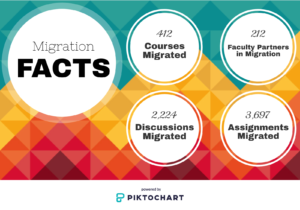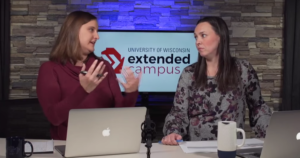
Mid-Course Surveys
Do your students have suggestions that could be incorporated into your course to make it a better experience for current and future students? Rather than waiting until the end of the course for feedback, instructors can ask for formative feedback from students midway through the course.
Although it may be hard to ask for feedback, the fact that you are asking shows how much you care about your students. The mid-course feedback is a way for instructors and students to share and respond to formative feedback, which can improve a course that is in progress and have a positive impact on learning now and in the future.
How to Design Questions
It is easy to create and set up a mid-course survey in Canvas. The survey should be anonymous (Canvas has a setting for anonymous responses) and can be as short as three short-answer questions.
To motivate students to provide feedback, it is important to emphasize in the survey’s instructions that student feedback is valuable and will be used to improve current and future learning experiences. If you would like to ask students for formative feedback, please contact your instructional designer for help in setting up a survey in your course.
Examples of formative feedback survey questions:
- What is one significant insight you have gained thus far in this course?
- What is one question about this course’s subjects that you still have?
- Please give your instructor one or two specific, practical suggestions of how they could help you improve your learning in this course.
Benefits of Conducting Mid-Course Surveys
There are several benefits to asking students for feedback in a mid-course survey:
- By asking open-ended questions during the course, instructors can show that they are interested and open to students’ feedback, which can help motivate students.
- The survey gathers the overall student perspective and gives the instructor time to respond to constructive feedback that can be implemented in the last half of the course.
- The instructor can serve as a good role model for students by constructively responding to both positive and negative feedback.
- Some students will be more receptive to formative feedback because they will see that the instructor is open to feedback as well.
- Responding to feedback acknowledges the students that provided feedback and manages student expectations for the remainder of the course.
- Instructors demonstrate that student feedback is valued with their willingness to incorporate recommended changes into the course and explain procedures or policies that may be confusing to students.
Tips for Follow-Up
After you ask students to complete the mid-course survey, it is important to respond to the formative feedback that you receive from students; we suggest that instructors respond by the end of the next week. Carefully consider what students say and look for themes that you can categorize their suggestions into for follow-up, such as the following:
- Items you can change during the semester and when you will make the changes
- Suggestions that need to wait until the next time the course is revised because of the impact on the remaining instruction in the course
- The aspects that you either cannot or will not change because of instructional reasons (e.g., assessments)
Talk to your instructional designer about creating a mid-course survey today!
Resources
- More information can be found in the Canvas Instructor Guide: How do I create a survey in my course?
- What Motivates Students to Provide Feedback to Teachers about Teaching and Learning? An Expectancy Theory Perspective
- Benefits of Talking with Students about Mid-Course Evaluations
- Mid-semester Teaching Evaluations (video)







